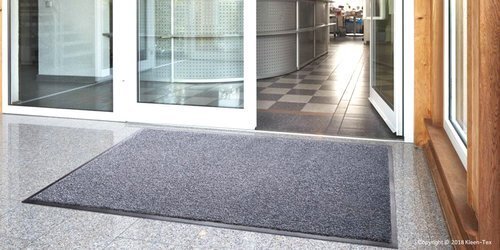Imagine walking into a space where every step you take contributes to the cleanliness and hygiene of the environment. Antibacterial floor mats, designed to eliminate bacteria and enhance safety, are revolutionizing the way we approach floor maintenance. In this article, we will explore the world of antibacterial floor mats, their benefits, applications, and how they can transform various industries. Get ready to discover the key to maintaining clean and bacteria-free floors!
Introduction to Antibacterial Floor Mats
When it comes to cleanliness and hygiene, floors play a crucial role. Whether it’s a healthcare facility, food service establishment, gym, or educational institution, maintaining a clean and bacteria-free environment is paramount. Traditional cleaning methods can only do so much, and that’s where antibacterial floor mats come into play. These innovative mats offer a proactive solution to combat bacteria, dirt, and moisture, ensuring a safer and healthier space for everyone.
The Importance of Maintaining Clean and Hygienic Floors
Clean floors not only enhance the aesthetics of a space but also contribute to the overall health and safety of its occupants. Bacteria and germs can easily accumulate on floors, posing a risk of contamination and infection. Regular cleaning methods, such as mopping and sweeping, may not effectively eliminate all bacteria, especially in high-traffic areas. Antibacterial floor mats provide an additional layer of protection, acting as a barrier against dirt, moisture, and harmful microorganisms.
Understanding Antibacterial Floor Mats
What Are Antibacterial Floor Mats?
Antibacterial floor mats are specialized mats designed to inhibit the growth and spread of bacteria on floors. They are typically made of high-quality materials infused with antimicrobial agents. These agents actively combat bacteria, fungi, and other harmful microorganisms, creating a cleaner and more hygienic environment.
How Do Antibacterial Floor Mats Work?
Antibacterial floor mats utilize various mechanisms to eliminate bacteria and maintain a clean surface. The antimicrobial agents embedded in the mats release ions that disrupt the cellular structure of bacteria, preventing their growth and reproduction. Additionally, the mats trap and absorb dirt, moisture, and contaminants, preventing their spread throughout the facility.
Benefits of Antibacterial Floor Mats
The utilization of antibacterial floor mats offers numerous advantages for different industries and settings. Some key benefits include:
- Improved Hygiene: Antibacterial mats actively reduce the presence of harmful bacteria and microorganisms, minimizing the risk of infections and diseases.
- Enhanced Safety: These mats provide slip-resistant properties, reducing the chance of accidents and falls due to wet or contaminated floors.
- Reduced Maintenance Efforts: By trapping dirt and moisture, antibacterial floor mats reduce the frequency of cleaning required for the underlying flooring, saving time and resources.
- Longevity of Flooring: With their protective properties, antibacterial mats help extend the lifespan of the flooring material by preventing wear and tear caused by dirt and debris.
Applications of Antibacterial Floor Mats
Antibacterial floor mats find applications in a wide range of industries, where hygiene and safety are of utmost importance. Let’s explore some key sectors where these mats are making a significant impact.
Healthcare Facilities
In hospitals, clinics, and other healthcare settings, maintaining a sterile and bacteria-free environment is critical. Antibacterial floor mats act as the first line of defense against dirt and contaminants brought in from outside. They help prevent the spread of bacteria and reduce the risk of healthcare-associated infections (HAIs).
Food Service Industry
In restaurants, commercial kitchens, and food processing facilities, maintaining impeccable hygiene is essential. Antibacterial floor mats provide a hygienic barrier against spills, grease, and bacteria, ensuring a safe working environment and reducing the chances of cross-contamination.
Gyms and Fitness Centers
Fitness facilities are prone to moisture and bacteria buildup due to high foot traffic and sweat. Antibacterial floor mats offer protection against bacterial growth, absorb sweat, and enhance slip resistance, reducing the risk of accidents and maintaining a clean and odor-free environment.
Schools and Educational Institutions
Schools and educational institutions cater to large numbers of students and staff, making them susceptible to the spread of infections. Antibacterial floor mats help reduce the presence of bacteria and contaminants brought in from outdoors, promoting a healthier environment for learning.
Choosing the Right Antibacterial Floor Mat
When selecting an antibacterial floor mat, several factors should be considered to ensure its effectiveness and suitability for the intended purpose.
Material and Durability
Antibacterial mats are available in various materials, such as rubber, vinyl, or carpet. Each material has its advantages, and the choice depends on factors like foot traffic, moisture levels, and ease of maintenance. Additionally, ensure that the mat is durable and resistant to wear, ensuring its long-term effectiveness.
Size and Placement
Consider the dimensions of the area where the mat will be placed. The mat should cover a sufficient surface area to effectively capture dirt and moisture. Additionally, strategically place mats in high-traffic areas and entrance points to maximize their efficiency in reducing the spread of bacteria.
Cleaning and Maintenance
Check the cleaning and maintenance requirements of the mat before making a purchase. Some mats can be easily cleaned with water and mild detergent, while others may require more specialized cleaning methods. Choose a mat that fits well with your cleaning protocols and can be easily maintained.
Enhancing Safety with Antibacterial Floor Mats
In addition to their antimicrobial properties, antibacterial floor mats offer several safety features that contribute to a secure environment.
Slip Resistance
Slip and fall accidents are a common concern in many industries. Antibacterial mats are designed with slip-resistant properties, providing additional traction and reducing the risk of accidents caused by wet or slippery floors.
Anti-Fatigue Properties
In workplaces where employees stand for extended periods, such as factories and assembly lines, anti-fatigue properties are essential. Antibacterial mats with cushioning and ergonomic designs help reduce fatigue and discomfort, enhancing productivity and overall well-being.
Cost-Effectiveness and Long-Term Savings
Investing in antibacterial floor mats offers long-term cost savings for businesses. By preventing damage to the underlying flooring, reducing cleaning requirements, and minimizing the risk of accidents, these mats contribute to a more efficient and cost-effective maintenance strategy.
The Future of Antibacterial Floor Mats
As hygiene and safety continue to be priorities in various industries, the demand for antibacterial floor mats is expected to rise. Ongoing research and development efforts aim to improve the efficacy and durability of these mats, making them even more effective in combating bacteria and maintaining clean environments.
Conclusion
Antibacterial floor mats provide a practical and efficient solution for maintaining clean, hygienic, and safe environments. By actively reducing the presence of bacteria, absorbing dirt and moisture, and enhancing safety features, these mats have become indispensable in industries such as healthcare, food service, and fitness. Investing in high-quality antibacterial floor mats not only promotes a healthier space but also contributes to long-term cost savings. With continuous advancements in technology, the future holds even more promising developments in antibacterial matting solutions.
FAQs
1. Are antibacterial floor mats effective against all types of bacteria?
Antibacterial floor mats are designed to combat a wide range of bacteria, fungi, and other microorganisms. However, their effectiveness may vary depending on the specific antimicrobial agents used and the contact time with the bacteria.
2. Can antibacterial floor mats be used outdoors?
Most antibacterial floor mats are designed for indoor use, as they may not withstand harsh weather conditions. However, there are specialized outdoor mats available that offer antibacterial properties along with weather resistance.
3. How often should antibacterial floor mats be cleaned?
The frequency of cleaning antibacterial floor mats depends on the level of foot traffic, environmental conditions, and the type of contaminants they encounter. Regular cleaning with water and mild detergent is usually sufficient for most mats, but follow the manufacturer’s guidelines for specific cleaning instructions.
4. Can antibacterial floor mats replace regular cleaning practices?
Antibacterial floor mats are a valuable addition to regular cleaning practices, but they should not replace them entirely. Regular cleaning of the underlying floor is still necessary to maintain overall cleanliness.
5. Do antibacterial floor mats have any side effects?
Antibacterial floor mats are generally safe for use, but it’s important to follow proper cleaning and maintenance protocols to avoid any potential issues. Some mats may have specific usage instructions or limitations, so it’s advisable to review the manufacturer’s guidelines before use.



